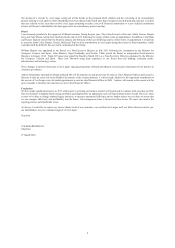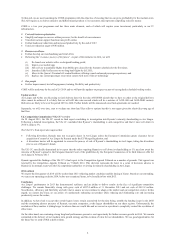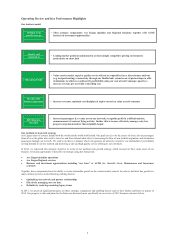Aer Lingus 2013 Annual Report Download - page 16
Download and view the complete annual report
Please find page 16 of the 2013 Aer Lingus annual report below. You can navigate through the pages in the report by either clicking on the pages listed below, or by using the keyword search tool below to find specific information within the annual report.
14
Other 2013 activity in relation to staff costs includes engagement in an independently chaired pay tribunal on pilots’ pay (which has yet to
conclude); action on staff absenteeism in peak seasonal periods and the greater use of fixed term employees during seasonally busy periods.
With regard to non-staff costs, Aer Lingus has agreed revised terms with a number of large maintenance providers which reduce the overall
cost of related contracts. We agreed revised payment arrangements with certain large suppliers in return for improvements in other
commercial terms and we are also examining ways to participate in infrastructural investment and development in Dublin Airport so that our
cost position would be improved. At the start of 2014, we moved to a new smaller, fit-for-purpose corporate headquarters in Dublin Airport
which should drive further process and efficiency improvements.
2014 priority: We have made progress in identifying, evaluating and implementing cost saving and productivity improvement measures
across the organisation but we firmly believe that more action is necessary to ensure Aer Lingus has the requisite flexibility and adaptability
to respond to market conditions. For this reason, a key element of the newly launched CORE programme is a €30 million cost reduction
target by the end of 2015 and we will provide updates on progress as part of our regularly scheduled trading results.
7. Continued evolution of internal structures to drive effective and efficient business operation
2013 priority: In order to remain competitive and profitable in the dynamic airline sector, it is imperative that we continually strive to
identify opportunities as they arise and to implement change when necessary. We make changes to our organisation structures to support
these goals where needed.
Progress achieved in 2013 and relevant key performance indicators: The key performance indicator here is qualitative rather than
quantitative and relates to the ability of the organisation to respond to challenges.
During 2013, we made certain changes to address specific organisational issues and since the start of 2014, we have announced some further
changes either to address areas where it is felt that improved performance is required or to increase the speed of change.
2014 priority: Our ability to react to market developments and adjust our operations to competitive pressures is crucial (as was evidenced in
the second half of 2013). However, our organisation must continue to evolve if it is to respond to ongoing market developments. Our 2014
priority will be to continue to identify further internal changes required and execute them on as timely basis as possible.
In particular, we will seek to leverage advantages from planned system and process changes to further adapt and streamline our internal
structures. In this regard and as part of the CORE programme, we expect to make important progress in 2014 with regard to upgraded IT
infrastructure in areas such as our passenger services, revenue accounting and baggage management. Aer Lingus has a number of legacy
hardware and software systems, which we are in the process of upgrading and replacing and work on this will continue in 2014.
8. Continued focus on demand led network management
2013 priority: Further optimise our integrated route network and explore whether latent demand on new routes could be profitably served by
Aer Lingus, either alone or with a partner. The continued development of our mainline network is consistent with our medium term growth
strategy. 2013 short haul capacity deployment was expected to be low mainly due to network changes relating to our Belfast base. However
long haul capacity was increased in order to serve increased demand in the transatlantic market.
2013 business outcomes and relevant performance indicators: Short haul capacity deployment was 4.1% lower than prior year due to:
The impact of scheduled fleet changes (specifically two A319 aircraft replacing two larger capacity A320 aircraft in our mainline short
haul fleet);
Changes to our underlying route network which saw overall short haul average sector length decrease as longer sector routes were
replaced with short sector flying; and
Tactical capacity reduction decisions taken in Q4 2013 in response to intensified fare pricing noted across Europe in the quarter. These
tactical adjustments were successful and we achieved a small increase in short haul load factor on a full year basis.
Long haul capacity deployment increased by 11.6% in 2013 due to:
The introduction of an additional (seventh) A330 aircraft in our mainline long haul fleet which allowed us to increase the frequency of
services from Dublin to Boston and Chicago (providing double daily services to both destinations and supporting network
connectivity), and
The earlier commencement of our Summer 2013 schedule which was launched in mid-March 2013
Network performance - capacity
ASKs
2013
Growth vs.
prior year %
2012
Growth vs.
prior year %
2011
Growth vs.
prior year %
Short haul (million)
11,954
(4.1%)
12,464
(0.4%)
12,509
2.6%
Long haul (million)
6,944
11.6%
6,221
2.3%
6,084
-
Total network (million)
18,898
1.1%
18,685
0.5%
18,593
1.8%
The response of load factor to capacity management is a key performance indicator in assessing network performance outcomes in 2013
(although the unit revenue metrics outlined earlier are also relevant in this regard).
Network performance – load factor
Load factor
2013
Growth vs.
prior year %
2012
Growth vs.
prior year %
2011
Growth vs.
prior year %
Short haul
75.6%
0.2 pts
75.4%
0.8 pts
74.6%
(0.3 pts)
Long haul
83.1%
0.6 pts
82.5%
4.9 pts
77.6%
(0.8 pts)
Total network
78.4%
0.7 pts
77.7%
2.1 pts
75.6%
(0.5 pts)
























